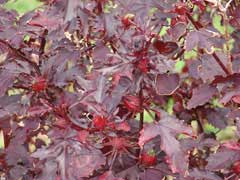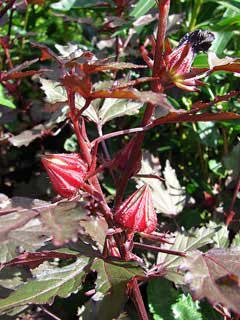 |
|
http://www.hear.org/starr/ |
 |
| http://www.hear.org/starr/ |
Translate this page:
Summary
Physical Characteristics

 Hibiscus acetosella is an evergreen Annual/Perennial growing to 1.5 m (5ft) at a medium rate.
Hibiscus acetosella is an evergreen Annual/Perennial growing to 1.5 m (5ft) at a medium rate.
See above for USDA hardiness. It is hardy to UK zone 10 and is frost tender. The species is hermaphrodite (has both male and female organs) and is pollinated by Insects. The plant is self-fertile.
It is noted for attracting wildlife.
Suitable for: light (sandy), medium (loamy) and heavy (clay) soils and prefers well-drained soil. Suitable pH: mildly acid, neutral and basic (mildly alkaline) soils. It cannot grow in the shade. It prefers moist soil.
UK Hardiness Map
US Hardiness Map
Synonyms
Hibiscus eetveldeanus De Wild. & T.Durand Hibiscus surattensis eetveldeanus (De Wild. & T.Durand) Hochr
Plant Habitats
Cultivated Beds;
Edible Uses
Edible Parts: Leaves Root
Edible Uses:
Leaves - raw or cooked. An acid flavour with a mucilaginous texture, they can be added to salads or used in soups, stews etc[183, 299, 308]. They can be cooked with other foods to give them an acid sorrel-like flavour[183]. Yellow-flowered types with green leaves are most popular for this purpose, but red-flowered types with dark red leaves are also eaten[299]. Types with decorative pinkish-brown leaves are used in fresh salads, being appreciated for their special rather sour taste[299]. The red flowers and possibly also the leaves are occasionally used to make a tea, somewhat similar to the use of the red calyces of Hibiscus sabdariffa[299]. Root - it is edible but is very fibrous[144]. Mucilaginous, without very much flavour[144, 299].
References More on Edible Uses
Medicinal Uses
Plants For A Future can not take any responsibility for any adverse effects from the use of plants. Always seek advice from a professional before using a plant medicinally.
An infusion of the leaves in water is used as a post-fever tonic and as a treatment for anaemia[299].
The leaves are crushed and soaked in cold water and the infusion is used for washing babies and young children who have body pains[299, 398].
References More on Medicinal Uses
The Bookshop: Edible Plant Books
Our Latest books on Perennial Plants For Food Forests and Permaculture Gardens in paperback or digital formats.

Edible Tropical Plants
Food Forest Plants for Hotter Conditions: 250+ Plants For Tropical Food Forests & Permaculture Gardens.
More

Edible Temperate Plants
Plants for Your Food Forest: 500 Plants for Temperate Food Forests & Permaculture Gardens.
More

More Books
PFAF have eight books available in paperback and digital formats. Browse the shop for more information.
Shop Now
Other Uses
Agroforestry Uses: Grown as a hedge in food gardens, where it can be used as a food as well as a barrier[299]. The form 'Red Shield' makes an ideal hedge[301].
The plant is highly resistant to root-knot nematodes and is, therefore, an excellent crop to be used after tomatoes or other solanaceous vegetables that are affected by nematodes[299]. 1. Nectary - Flowers rich in nectar and pollen:
Yes – The flowers of Hibiscus produce nectar that attracts pollinators, including bees and butterflies.
2. Wildlife - Food (Fruit, Seeds, Leaf litter, Shelter, Nesting, Roosting):
Yes – The leaves and seeds are edible and can be used as food sources for both wildlife and humans. The plant may provide some shelter due to its dense foliage, though it’s not a primary nesting site for birds.
3. Invertebrate Shelter (Overwintering sites, Leaf litter, Groundcover):
Yes – It can provide habitat for beneficial insects, and its foliage may contribute to leaf litter, which can serve as a refuge for invertebrates.
4. Pest Confuser (Smell):
No – While the plant has a pleasant smell, it is not primarily known for confusing pests or deterring them.
Special Uses
References More on Other Uses
Cultivation details
Hibiscus acetosella is found over a large area of tropical Africa, usually being grown at low to moderate elevations. It can also be grown as an annual in warm temperate areas. It grows best in areas with good rainfall[299].
Succeeds in a sunny position, but prefers some shade[299]. Prefers a well-drained humus-rich fertile soil[200]. There are some named varieties[200]. Plants are resistant to root-knot nematodes[298].
References Carbon Farming Information and Carbon Sequestration Information
Temperature Converter
Type a value in the Celsius field to convert the value to Fahrenheit:
Fahrenheit:
The PFAF Bookshop
Plants For A Future have a number of books available in paperback and digital form. Book titles include Edible Plants, Edible Perennials, Edible Trees,Edible Shrubs, Woodland Gardening, and Temperate Food Forest Plants. Our new book is Food Forest Plants For Hotter Conditions (Tropical and Sub-Tropical).
Shop Now
Plant Propagation
Seed - sow early spring in a warm greenhouse. Germination is usually quite rapid. Prick out the seedlings into individual pots when they are large enough to handle and plant them out into their permanent positions in early summer. Give them some protection until they are growing away well. A sowing outdoors in situ during April might work, though if the summer is cool the plants might not flower and set seed. Cuttings - easy.
Other Names
If available other names are mentioned here
False Roselle, African rosemallow, Cranberry Hibiscus
Native Range
AFRICA: Sudan, Tanzania, Uganda, Cameroon, Democratic Republic of the Congo, Congo, Sao Tome and Principe, Côte D Ivoire, Angola, Mozambique, Zambia, Zimbabwe, Mauritius.
Weed Potential
Right plant wrong place. We are currently updating this section.
Please note that a plant may be invasive in one area but may not in your area so it's worth checking.
Conservation Status
IUCN Red List of Threatened Plants Status :

| Related Plants
|
| Latin Name | Common Name | Habit | Height | Hardiness | Growth | Soil | Shade | Moisture | Edible | Medicinal | Other |
| Hibiscus cannabinus | Kenaf, Brown Indianhemp | Annual/Perennial | 1.8 |
6-12
| F | LMH | N | M | 4 | 2 | 3 |
| Hibiscus diversifolius | Swamp Hibiscus | Shrub | 1.0 |
9-11
| | LMH | N | M | 2 | 1 | |
| Hibiscus heterophyllus | Native Rosella | Shrub | 1.8 |
9-11
| | LMH | N | M | 2 | 0 | 1 |
| Hibiscus moscheutos | Swamp Rose Mallow, Crimsoneyed rosemallow, Wild Cotton, Common Rosemallow, Eastern Rosemallow, Swamp | Perennial | 2.5 |
6-9
| M | LMH | SN | M | 1 | 2 | |
| Hibiscus mutabilis | Cotton Rose, Dixie rosemallow | Shrub | 3.0 |
7-10
| | LMH | N | M | 2 | 2 | 1 |
| Hibiscus radiatus | Monarch Rosemallow. Ruby hibiscus, Clavelina | Shrub | 2.0 |
9-11
| M | LMH | SN | M | 2 | 1 | 2 |
| Hibiscus rosa-sinensis | Chinese Hibiscus, Shoeblackplant, Hawaiian Hibiscus, Tropical Hibiscus, China Rose, Rose-of-China, S | Shrub | 2.5 |
9-11
| F | LMH | N | M | 3 | 3 | 3 |
| Hibiscus sabdariffa | Roselle | Annual/Perennial | 3.0 |
9-12
| F | LMH | N | M | 3 | 3 | 3 |
| Hibiscus sinosyriacus | Rose Of Sharon | Shrub | 3.0 |
6-9
| M | LMH | SN | M | 4 | 2 | 3 |
| Hibiscus syriacus | Rose Of Sharon, Althaea, Shrub Althea, Hardy Hibiscus | Shrub | 3.0 |
5-9
| M | LMH | SN | M | 4 | 2 | 2 |
| Hibiscus tilliaceus | Beach Hibiscus, Sea Hibiscus | Tree | 8.0 |
10-12
| F | LM | N | DMWe | 2 | 1 | 3 |
| Hibiscus trionum | Flower Of An Hour | Annual/Perennial | 0.6 |
9-11
| F | LMH | N | DM | 2 | 1 | 2 |
| Talipariti tiliaceum | Beach Hibiscus, Sea Hibiscus, Cottontree, Mahoe | Tree | 10.0 |
10-12
| F | LMH | N | MWe | 3 | 2 | 4 |
|
Growth: S = slow M = medium F = fast. Soil: L = light (sandy) M = medium H = heavy (clay). pH: A = acid N = neutral B = basic (alkaline). Shade: F = full shade S = semi-shade N = no shade. Moisture: D = dry M = Moist We = wet Wa = water.
Now available:
Food Forest Plants for Mediterranean Conditions
350+ Perennial Plants For Mediterranean and Drier Food Forests and Permaculture Gardens.
[Paperback and eBook]
This is the third in Plants For A Future's series of plant guides for food forests tailored to
specific climate zones. Following volumes on temperate and tropical ecosystems, this book focuses
on species suited to Mediterranean conditions—regions with hot, dry summers and cool, wet winters,
often facing the added challenge of climate change.
Read More
Expert comment
Author
Welw. ex Hiern.
Botanical References
200
Links / References
For a list of references used on this page please go here
Readers comment